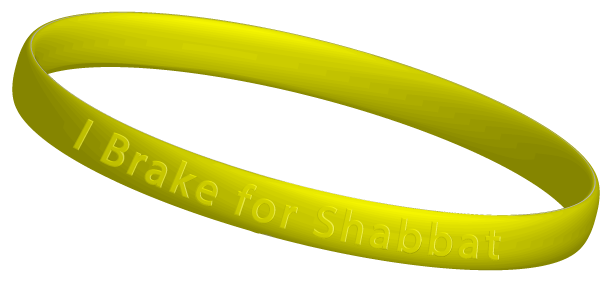By Jonathan Lubliner, Jacksonville Jewish Center, Jacksonville, FL
The Project:

Anyone who has ever spent a Shabbat in a largely Sabbath-observant neighborhood can attest to the palpable and pervasive atmosphere of community experienced when families are walking to or from services, passing one another in the street and exchanging greetings of “Shabbat Shalom.” Such neighborhoods – even those located in suburbia – take on an organic sense of community, at least one day in seven. As Jews have known for millennia, the celebration of Shabbat can be a powerful centripetal force for Jewish togetherness.
Tiyul to Shul was designed to utilize the community-building aspect of Shabbat while simultaneously taking into account the reality that suburban life depends on automobile travel. By encouraging some element of walking in the company of others to synagogue (the Hebrew word tiyul is used here to denote walking with a purposeful goal), we believe that the simple act of strolling and chatting with fellow shul-goers fosters a greater sense of connection with community. At the same time, the creation of “Park and Walk” zones reflects our understanding that driving is intrinsic to virtually all travel in suburban regions. The beauty of this program is due in no small measure to its minimal cost, easy implementation, and tangible benefit.
The program is targeted to include the entire community.
Individuals who live within a 1-2 mile radius of the synagogue often opt to walk at their own leisure, often with fellow synagogue-goers from the same neighborhood. Individuals who live at greater distances arrive at the “Park and Walk” areas at their own leisure, and walk to the synagogue from there on their own or together with fellow worshippers by mutual arrangement. The synagogue also schedules larger group to walk from the “Park and Walk” areas for those who had no one to walk with or simply wanted the experience of walking to services with a larger group of individuals. Each group was led by a designated synagogue member, and departed the respective “Park and Walk” sites at different times. Our pre-school families opted to walk as a group, as did members of various elementary school grades. Middle school students walked from another area, while a USY contingent did so as well. Following the conclusion of services, our USYers generally walk to a nearby member’s home for Shabbat lunch and an afternoon program.
Even our local Jewish Boy Scouts’ troop, has gotten involved, volunteering at the “Park and Walk” sites to accompany those with physical challenges who want to walk or participate in the event from a wheelchair.
The Project’s Impact:
Tiyul to Shul is held each December (ideal walking weather in Florida) and has become an integral part of the shul’s programming calendar. There has been uniformly positive feedback from those who walk. Comments have included: how nice it is to slow down and walk leisurely on Shabbat; how wonderful it is to walk with friends; or how enjoyable it is to see and experience a sense of solidarity in community with others walking to services.
Tiyul to Shul has helped foster a palpable sense of community on numerous levels.
Pre-school families, grade school students, USYers and congregants of all ages walk with one another to services. In any number of cases, synagogue members met other congregants for the first time while participating in Tiyul to Shul.
As a result of Tiyul to Shul, congregants have begun to walk to synagogue on Shabbat more frequently, opting to leave their car at home in favor of the leisurely joy of strolling to services with friends and family.
DIY (Do-it-Yourself) Tips:
We begin to publicize the program approximately six weeks in advance. A front page bulletin article and an entire rabbi’s column were devoted to the event the year Tiyul to Shul made its debut Flyers with the relevant information are distributed to children and their parents in all our congregational schools, i.e., synagogue’s day school, afternoon religious school, and pre-school. In its first year, the week before the program, the rabbi’s Shabbat sermon [*link] focused on Tiyul to Shul.
In order to further raise the profile of Tiyul to Shul, special T-shirts are created and given to synagogue leaders, day school and religious school teachers. They are asked to wear their Tiyul to Shul shirts several days before the event. At a day school assembly the week before the event, the rabbi and Judaic teachers have performed a skit or spoof a song that encourages the fun aspect of participation in Tiyul to Shul. Publicity and personal invitations from those involved in the programming aspect are key elements to making Tiyul to Shul successful!
We also order Tiyyul to Shul bracelets several weeks in advance. Each bracelet is embossed with the words “JJC Tiyul to Shul” as well as the phrase “Shabbat in the Slow Lane” or “I Brake for Shabbat.” These bracelets are awarded to any person who walks to services that day, whether from their own home or someone else’s, or any of the “Park and Walk” areas. Their value as a modest trophy item notwithstanding – they are especially prized by kids – the distribution of the bracelets to walkers also enables us to tally accurately the number of individuals participating in Tiyul to Shul.
It’s anti-climatic for Tiyul to Shul to end with one’s arrival at the front door of the building.
We almost always pair Tiyul to Shul with a Synaplex™ Shabbat to maximize the advantage of having a very diverse population in the building. Yoga, Meditation, Davening 101 workshops, Torah discussions are frequently offered in addition to regular Shabbat worship. We have done character breakfasts for our pre-school population the morning of Tiyul to Shul (because it takes place in December in proximity to Hanukkah, we have parents who dress up as Maccabees), followed by a Gan Shabbat or PJ Library program. Often our Men’s Club and Sisterhood will host a book review or discussion and sponsor a light lunch after services that day.
Some years we’ve used Tiyul to Shul as a part of a New Member Shabbat. In other years, Tiyul to Shul has been linked to timely messages about environmentalism or physical fitness.
We frequently appoint a synagogue member each year to serve as “Walking Matchmaker,” to help connect those who want to walk with others at specific times and/or from different sites do so.
I am proud of the extent to which the program has become embedded in the rhythm of the synagogue’s programming. It’s gratifying to see the ways in which Tiyul to Shul generates a stronger sense of community.
Born and raised in Westchester County, New York, Jonathan Lubliner earned his bachelor’s degree with honors from Vassar College in 1985. He received his MA from the Jewish Theological Seminary of America, where he was also ordained and later pursued doctoral studies in Jewish history. Rabbi Lubliner served congregations in Connecticut and New Jersey before becoming the Senior Rabbi of the Jacksonville Jewish Center in the summer of 2004.
His involvement in the larger community beyond the pulpit has encompassed a wide range of activities. Since 2005 he has been a visiting rabbinic instructor at Camp Ramah Darom, and prior to that, at Camp Ramah in the Berkshires, where he also served as Rabbi-in-Residence for Imun, United Synagogue’s international lay leadership training program. A Judaic Studies curriculum advisor to the Solomon Schechter Day School of Raritan Valley, during his years in New Jersey Rabbi Lubliner was also appointed to the Municipal Ethics Board of Old Bridge Township, and co-founded a local interfaith consortium to promote dialogue and better understanding between different religious communities.
An executive board member of both the Connecticut Valley and New Jersey regions of the Rabbinical Assembly, in the autumn of 2001 Rabbi Lubliner became the Dean of the Institute for Conversion and Outreach Education, a program of the New Jersey region of the Rabbinical Assembly, serving more than sixty affiliated congregations within the state. From 2006 to 2010 he served as Chair of the Taskforce on Conversion for the Rabbinical Assembly, the international body of the Conservative rabbinate, and is the author of the recently published Petah Ha-Ohel – At the Entrance of the Tent: A Rabbinic Guide to Conversion. A current member of the Rabbinical Assembly’s Commission on Keruv, Conversion and Peoplehood, Rabbi Lubliner was appointed to the Chancellor’s Rabbinic Leadership Council of the Jewish Theological Seminary of America in 2009 and became a member of the Conservative movement’s Committee on Jewish Law and Standards in 2011.
A second generation rabbi, Jonathan Lubliner is blessed by his marriage to Susan, a Judaic artist and Hebrew calligrapher, and privileged to be the father of the couple’s three children, Avichai, Elior and Itamar. He enjoys cooking, reading, weightlifting and biking, and is a loyal fan of the New York Yankees.

